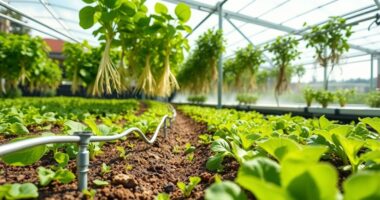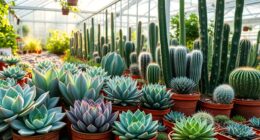When choosing between drip and misting systems for your greenhouse, consider your crop needs and climate. Drip irrigation delivers water directly to roots, conserving water and reducing disease risk, making it ideal for most vegetables and ornamentals. Misting increases humidity and cools plants but uses more water and requires careful management. Understanding your specific requirements can help you select the best system, and exploring further will reveal how combining these methods can optimize your irrigation approach.
Key Takeaways
- Drip systems deliver targeted water directly to roots, maximizing efficiency and reducing waste, ideal for most crops.
- Misting systems increase humidity and cool plants but require careful management to prevent overwatering and fungal issues.
- Drip irrigation conserves water through precise delivery, while misting covers larger areas with higher water usage.
- Combining both systems can optimize moisture control, benefiting diverse plant needs and environmental conditions.
- System choice depends on crop type, climate, and water conservation goals for sustainable greenhouse management.

Effective irrigation is essential for maintaining healthy plants in greenhouses, ensuring they receive the right amount of water at the right time. When you manage your irrigation system effectively, you can optimize soil moisture levels, which is crucial for plant growth and productivity. Proper soil moisture prevents both drought stress and waterlogging, creating an ideal environment for roots to develop and absorb nutrients efficiently. Additionally, efficient watering methods help conserve water, a vital resource in sustainable greenhouse operations. By focusing on water conservation, you reduce waste and lower operational costs, making your greenhouse more environmentally friendly and economically viable.
Effective greenhouse irrigation optimizes soil moisture, conserves water, and promotes healthy, productive plant growth.
Drip irrigation is a popular choice because it delivers water directly to the plant roots through a network of tubes and emitters. This targeted approach ensures consistent soil moisture around each plant, minimizing water runoff and evaporation. As a result, you spend less water overall while maintaining optimal soil conditions. Drip systems also allow you to set precise watering schedules, which is especially useful when managing diverse plant types with varying moisture needs. Because water is delivered slowly and directly to the soil, you’re less likely to overwater, reducing the risk of disease caused by excess moisture. Furthermore, drip irrigation reduces weed growth since water isn’t dispersed across the entire planting bed, only where it’s needed. This system is particularly effective when combined with soil moisture sensors, giving you real-time feedback to fine-tune watering schedules and further conserve water.
Misting systems, on the other hand, create a fine spray of water that increases humidity and cools plants on hot days. They’re excellent for maintaining uniform moisture levels in the air and on the plant surfaces, which is beneficial for certain crops like orchids or tropical plants that thrive in high humidity environments. However, misting systems tend to use more water than drip irrigation because they cover a larger area. If not managed carefully, they can lead to excessive soil moisture and potential fungal problems. To maximize water conservation with misters, you should implement timers and humidity sensors, ensuring the spray runs only when necessary. Properly used, misting can complement drip irrigation by maintaining ambient humidity without wasting water, but it requires careful monitoring to prevent overuse.
In choosing between drip and misting systems, consider your crop types, climate conditions, and water-saving goals. Drip irrigation provides precise, efficient watering that conserves water by targeting roots directly, making it ideal for most vegetables and ornamentals. Misting, while beneficial for humidity control, demands more careful management to avoid excess water use. Both systems, when properly integrated and monitored, help you maintain optimal soil moisture and promote water conservation, leading to healthier plants and a more sustainable greenhouse environment. Additionally, selecting the right system based on your specific plant needs can significantly improve overall watering efficiency and plant health.
Frequently Asked Questions
How Do Drip and Misting Systems Impact Plant Disease Risk?
Drip systems reduce plant disease risk by minimizing pathogen spread because they deliver water directly to roots, keeping foliage dry. Misting systems, however, increase humidity, which can promote fungal diseases and accelerate pathogen spread. Proper humidity control is essential with misting to prevent over-accumulation of moisture. You should monitor humidity levels carefully and maintain good air circulation to reduce disease risks associated with both irrigation types.
What Is the Typical Lifespan of Each Irrigation System?
Your irrigation system’s lifespan can be as long as a lifetime if you choose wisely. Drip systems typically last 10-15 years with proper maintenance, thanks to their durability comparison and fewer moving parts. Misting systems often last 5-10 years, but require more maintenance to prevent clogging. Regular checks, cleaning, and replacing worn parts help extend each system’s life, ensuring your greenhouse stays lush and productive longer.
Which System Is More Energy-Efficient for Greenhouse Operations?
Misting systems are generally more energy-efficient for greenhouse operations because they consume less energy on water distribution and require less pressure. This reduces overall energy consumption and lowers operational costs. Drip systems, while precise, often use more energy due to higher pressure and longer run times. By choosing misting, you can save on energy costs and improve sustainability, making it a smart option for efficient greenhouse management.
How Do Climate Conditions Influence System Selection?
Climate conditions greatly influence your system choice. In hot, dry environments, misting systems offer climate adaptability by providing cooling and humidity, while drip systems excel in arid conditions, conserving water. You should customize your irrigation system to match these conditions, ensuring ideal plant health and efficiency. Proper system customization allows you to adapt to changing climate patterns, making your greenhouse more resilient and productive regardless of external weather fluctuations.
Can Both Systems Be Integrated for Optimal Watering?
Yes, you can integrate drip and misting systems for ideal watering. For example, a greenhouse might use drip irrigation for deep root watering while misting provides humidity control. This system integration boosts efficiency maximization by ensuring plants receive precise moisture levels without overwatering. Combining both methods allows you to adapt to different plant needs and climate conditions, enhancing overall growth and resource use.
Conclusion
Choosing between drip and misting systems depends on your greenhouse’s needs. For example, a tomato grower switched to drip irrigation and saw healthier plants and less water waste. By tailoring your system, you guarantee ideal moisture levels and plant growth. Whether you opt for precise drip lines or a gentle mist, your plants will thrive. Invest thoughtfully, and you’ll enjoy bountiful harvests and efficient water use all season long.








